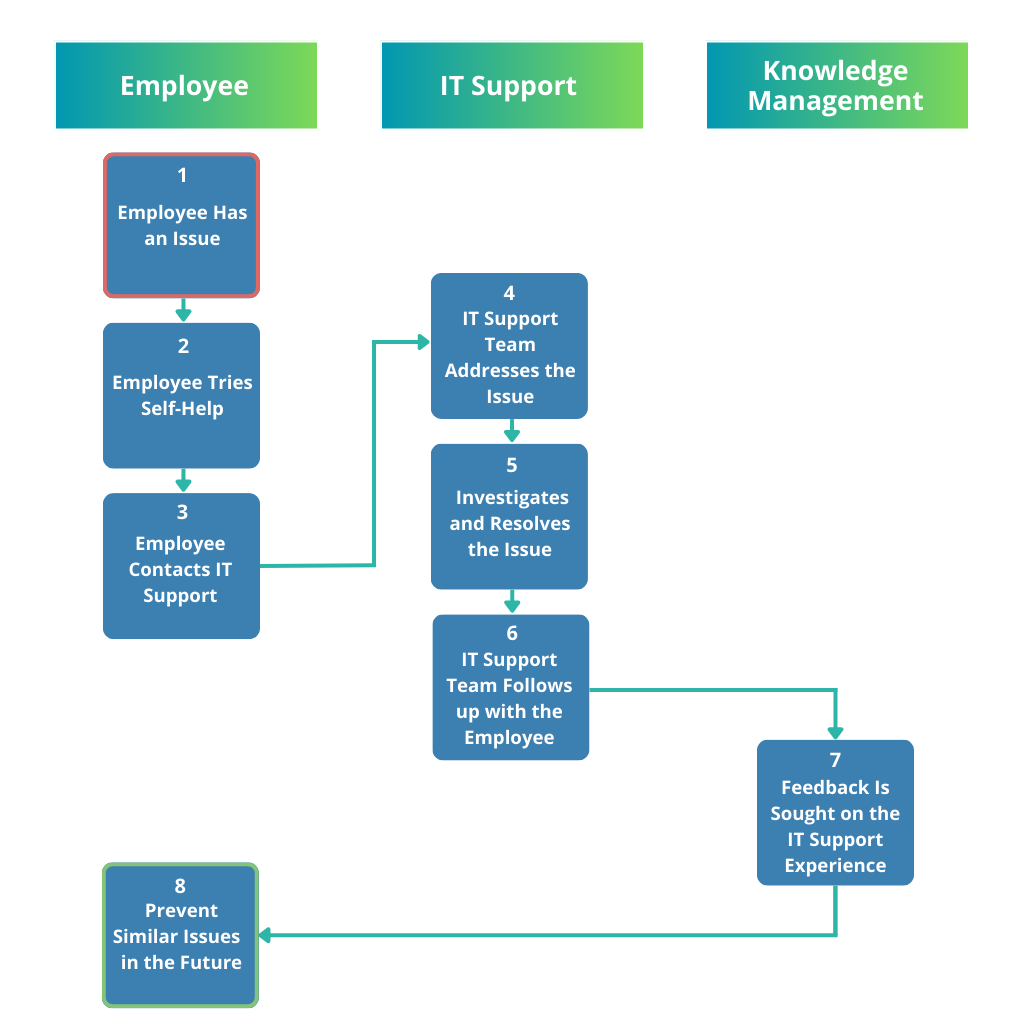
The Importance of Customer Journeys to IT Service Desks
With all of the IT industry interest in employee experience (EX), you might be looking for insight into the what, why, and how of customer journey mapping and how it improves IT support operations and outcomes for employees. To help, this blog introduces customer journey mapping and how it will improve your IT service desk.
This blog by @Joe_the_IT_Guy introduces customer/employee journey mapping and how it will improve your IT service desk. #servicedesk #ITSM Click To TweetThe “what” of customer journeys, and are they customer journeys or employee journeys?
The honest answer is: call the journey mapping what you feel most comfortable with. In the same way that customer experience (CX) preceded employee experience, customer journey mapping preceded employee journey mapping. They’re very similar, and what you call the improvement activity you undertake is far less important than the outcomes.
Customer journey mapping started in the fields of service and user experience (UX) design – as a way to visualize the customer pain points and opportunities for improvement in the customer experience. Similarly, employee journey mapping is the process of understanding and visualizing employees’ experiences as they interact with service providers, such as IT, within an organization. As with employee experience, this is from when the employee is recruited through to their exit. It results in a more positive and engaging work environment for employees.
This blog refers to the employee journeys with IT support as “customer journeys,” but you’re free to use whatever terminology best suits your organization and its culture.
Here @Joe_the_IT_Guy explains why service desks should be using 'customer journey mapping' for its employees. #servicedesk #EX Click To TweetThe “why” of customer journeys for IT service desks
IT service desks should use customer journey mapping for many reasons, including to:
- Better understand employee needs – with services changed to align with end-user expectations (within budgetary limitations)
- Uncover previously hidden employee pain points – because customer journey mapping identifies critical issues that go unnoticed with traditional IT service desk metrics
- Improve employee experiences – by identifying and addressing pain points
- Increase operational efficiency – by identifying bottlenecks and inefficiencies in IT support processes
- Provide better communications – by understanding both end-user needs and expectations
- Better align IT support operations with business needs – prioritizing resources and making more informed decisions
- Increase end-user productivity – with less employee time lost through unnecessary remediation and provisioning delays
- Increase IT service desk reputation and use – because employees value the experience and outcomes received from the IT service desk.
The “how” of customer journeys
Take a look at these 11 steps for customer/employee journey mapping for IT support via @Joe_the_IT_Guy #EX #servicedesk #ITSM Click To TweetCustomer journey mapping for IT support involves some key steps, including:
- Defining the objectives and goals for the customer journey mapping. This initial thinking and agreement will help ensure alignment with your business goals.
- Identifying the different employee personas and involving key business stakeholders. Importantly, not all employees and how they engage IT support are the same hierarchically.
- Understand the common IT support journeys and pick one to focus on. Giving any customer journey the focus it needs and deserves will be impossible without this focus.
- Identifying the key stages of the chosen customer journey. Depending on the complexity of the customer journey, a stage-based approach might be required.
- Mapping out the customer journey (or stage) touchpoints. Focus on the key touchpoints that are most important to the customer (and this needs to reflect the different employee personas). It’s essential to map the journey from the customer’s perspective, not IT support’s.
- Gathering data related to the journey. This data will come from various sources, including employee feedback from interviews and workshops, periodic and transactional IT support surveys, IT service desk interactions, and performance management data.
- Visualizing the customer journey. This visualization is commonly started via Post-It-Note-based flowcharts on whiteboards.
- Identifying the employee pain points. As the customer journey is visualized, look for pain points or areas where IT support customers experience issues.
- Checking the initial visualization and pain points with stakeholders. This activity confirms the aggregated data and insights and can be used to highlight improvement priorities.
- Creating and introducing improvement-focused solutions to address key employee experience (EX)
- Testing the changes and their impact and iterating. Both of these are important, with the need to regularly revisit the customer journey map.
Common customer journey mapping mistakes
So that’s what to do with customer journey mapping. I also find it helpful to know what not to do. So, here are some tips on the common customer journey mapping mistakes to avoid:
- Don’t over-focus on the IT support perspective – ensure that you create your customer journey map(s) from the employee perspective
- Don’t start visualizing with insufficient data – this applies to the volume and the sources used
- Don’t create a “one-size-fits-all” customer journey map – ensure that the different employee personas are reflected
- Don’t be imbalanced – customer journey maps should highlight both positive and negative experiences.
An example customer journey map for IT support
All the above is “all well and good,” but what does a customer journey map for IT support look like? Here’s a very high-level example for an incident:

- The employee has an issue with their technology.
- The employee might try to self-help by asking colleagues or searching the internet for potential solutions to their issue.
- The employee contacts the IT support team via phone (or email or chat) for assistance (this might be after trying the IT self-service facilities).
- The IT support team triages the employee’s issue by categorizing, prioritizing, and routing it to the appropriate resolution group. IT support personnel might also gather additional information about the issue.
- The IT support team investigates and resolves the employee’s issue.
- The IT support team follows up with the employee to ensure the issue has been resolved and closes the related ticket.
- Feedback is sought on the IT support experience.
- Knowledge management, problem management, and change enablement activities might be undertaken to prevent similar issues from occurring in the future.
Your IT-support customer journey map might be far more complicated. Still, the key touchpoints will be the most critical elements, especially where the IT support process(es) causes employee issues.
What are your thoughts on customer journey mapping? Is it something you’ve tried in your organization? Let me know in the comments.






